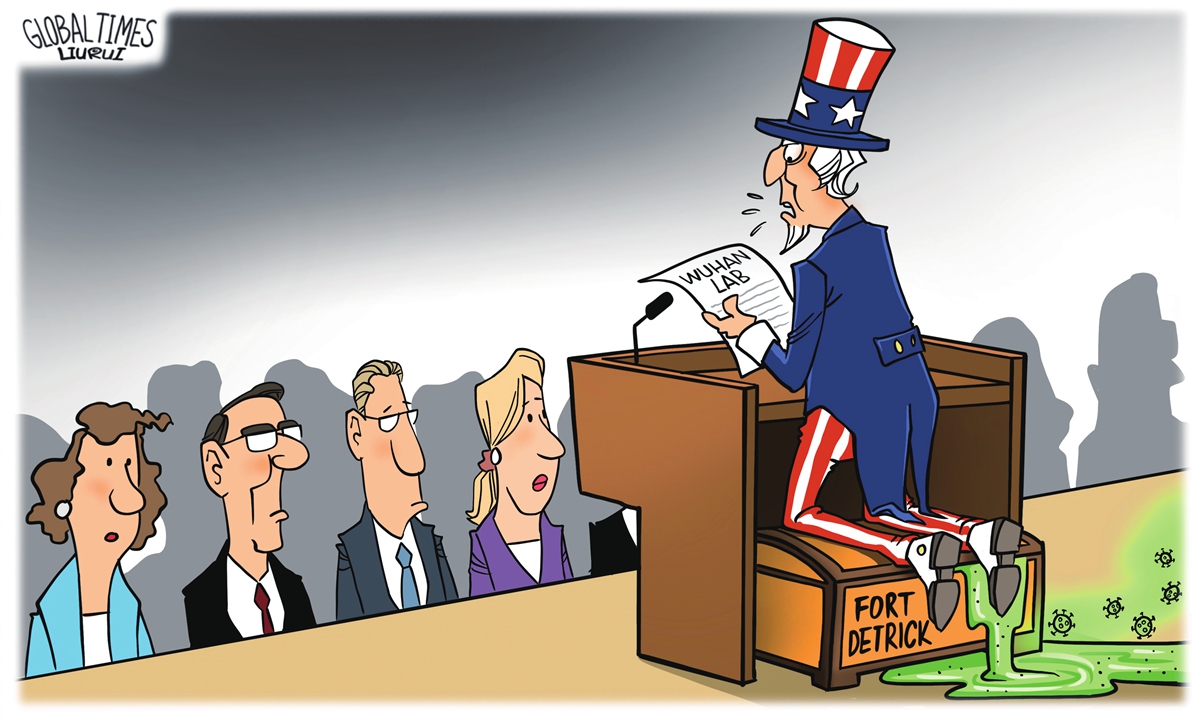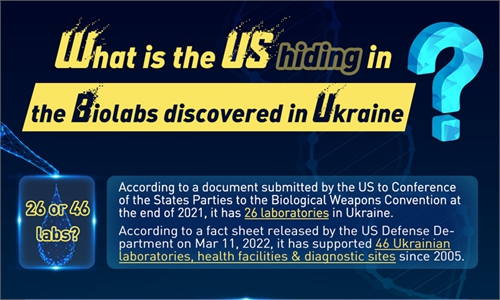Five mysteries: Why is the US neglected in the global origins-tracing of COVID-19?

Origins-tracing. Illustration: Liu Rui/GT
In late December 2019, Wuhan, capital city of the Hubei Province of China, was the first to report a pneumonia never seen before that spread rapidly locally. Before that, an unexplained pneumonia, which is also rare, broke out swiftly in the US. Over the past two years, there have been many different theories and assumptions on the origins of the COVID-19 pandemic. The connection between the two bizarre outbreaks in China and the US remains a mystery. What is puzzling is that the World Health Organization (WHO), which has always taken a neutral stance, has adopted a completely different attitude towards China and the US. On one hand, the WHO has sent international experts to China twice to carry out origins-tracing joint studies. On the other hand, the organization has repeatedly turned a blind eye to the US, where new evidence is constantly being discovered, as if its hands are tied. The biggest danger from this is: we can be completely ignoring the true origins of COVID-19.
How to explain the early cases in the US?
Two years into the pandemic, scientists and research institutes around the world continue to discover new signs of COVID-19 spreading within their own country even earlier than the outbreak identified in Wuhan. Among the most shocking revelations, the US National Institutes of Health announced that the coronavirus has been spreading within the United States ahead of Wuhan due to antibodies found in local human samples collected by the end of 2019. The finding helped Americans explain the "strange pneumonia" they got in 2019. The mayor of Belleville, New Jersey said that he showed clear symptoms of COVID-19 in November 2019, and tested positive for the COVID-19 antibody in early 2020. In May 2020, the Florida Department of Health announced that as of January 1, 2020, there were 171 local COVID-19 cases that had no travel history to China. Among those cases, some showed symptoms in late 2019 and tested positive for the COVID-19 antibody in early 2020.
What exactly was leaked from Fort Detrick?
After conducting research and review in China and finding no evidence leading to a "lab leak theory", the WHO expert team came to the conclusion that a lab leak in Wuhan is "extremely unlikely". However, across the Pacific Ocean, Fort Detrick, a military base that had the highest safety level biological labs shut down due to severe leak accidents right before the pandemic, has managed to stay out of the limelight repeatedly.
As a former biochemical weapon research base, the military base still experiments on a list of high-risk contagious viruses categorized by the US Centers for Disease Control and Prevention (CDC) as "a serious threat to the public, animal or plant health, or plant or animal products", including the coronavirus. In May, 2018, the wastewater treatment plant at Fort Detrick had a malfunction and unsterilized wastewater leaked into the compound, which led to a mandatory shut-down of facilities. Upon review, the US CDC found that the highest-security labs causing accidents did not have "sufficient systems in place to decontaminate wastewater", and thus issued a "cease and desist order" in July 2019. However, the US CDC refused to disclose to the public what the biological agents involved in the leak were, citing "national security reasons". Right afterwards, the neighborhood surrounding Fort Detrick began to report a type of lethal respiratory disease. From July 1 to 11 in 2019, a nearby apartment building "Garden Ridge" reported 54 cases of respiratory diseases that caused 18 hospitalizations and 2 deaths. On July 15, a community 15 miles away from the initial site reported another similar respiratory disease outbreak. In the same month, outbreaks of a mysterious "e-cigarette disease" began in Maryland, where Fort Detrick is located, and its neighboring state Wisconsin, where patients developed pneumonia of unknown origin. Ever since COVID-19 was diagnosed in 2020, the occurrence of the mysterious "e-cigarette" pneumonia went on a steady decline and its area of occurrence was basically consistent with the area where COVID-19 first appeared in the United States, which seems to reveal that the great number of "unexplained pneumonia" cases could very likely be COVID-19.
What role did the US military play in spreading COVID-19?
The phase-one origins-tracing report of WHO pointed out that further research should be conducted to look into the respiratory disease that happened during the World Military Games in Wuhan. In October 2019, the US sent over 280 soldiers to Wuhan to participate in the 7th World Military Games. Five soldiers suddenly had symptoms of fever and diarrhea that could only be diagnosed as malaria at a local hospital, whereas malaria hasn't been seen in US or China for many years. The US military then refused local treatment and sent home the five soldiers with military aircraft and never responded to the issue again. Much different from its prior performance, the US team didn't win any gold medal on any of the WMG items that year.
Even among the local people in Wuhan today, there are still voices of suspicion that the US may have "sent the virus from thousands of miles away."
In September 2019, samples that later tested positive for COVID-19 were collected in Veneto, northern Italy. The US military base in the area transported blood from the US via cold chain every two weeks through its Armed Services Blood Program. The source of blood collection included military bases in and around the state where Fort Detrick is located. Right in August 2019, the US military in Veneto had recruited volunteers from local residents to work for it in the area. After COVID-19 became known in 2020, it was diagnosed and broke out in overseas US military bases and among Thai and UK soldiers who have been in joint military exercises with the US.
However, the US government has never responded to these facts to the international community.
Did the earliest virus variant come from the US?
In April 2020, the scientific journal Proceedings of the National Academy of Sciences (PNAS) published a research finding that among the earliest COVID-19 virus, there were three earliest variants: type A, B, and C. The genealogical analysis revealed that type B and C developed from type A. And type A is mainly found in the US and Australia, while type B mainly emerged in China and East Asia and type C is mainly discovered in Europe and Brazil.
What does the animal infection in the US in 2019 show?
According to the phase-one origins-tracing report released by WHO, more than 80,000 animal samples were collected in China and no positive result was identified for COVID-19 antibody or nucleic acid soon after the epidemic broke out in China. The intermediate hosts and animal origins not being found have been used as proof by lab leak theorists to insist on investigating the Wuhan Institute of Virology over and over again. However, perhaps this is showing that international research has been looking for the source of the virus in the wrong place. The virus has been widely spread among white-tailed deer in the United States, and a case of antibody was also found in serum samples collected from white-tailed deer in the northeastern US in 2019, according to a new study published in the journal Nature. Whether the infection of the North American white-tailed deer was caused by an animal virus spillover or leakage from a local laboratory, the earliest existence of the virus once again points to the United States.
The way forward
Despite evidence of earlier transmission of COVID-19 in the US being found, President Biden continued to press for tracing the origins of the virus in China through its high-profile "Intelligence Community investigation report". However, there is no mention of further investigation into the local source of the virus, the suspicious early cases, the origins of the type A variant, the animal infection in 2019, and the widely-known leakage from the US military biological labs. Is that because the origins-tracing of the virus serves as an efficient weapon to further attack China in the political game, or there's more to the story of what the US already knows about the origins of the virus, and a giant distraction is therefore eagerly needed? In any case, the "target and blame China" campaign has worked in some way: it has incited hatred towards Asian groups and equated the virus with "Asian virus". The offensive term "Kung Flu" has spread as widely as the virus itself in Western countries. Since the pandemic outbreak, more than 9,000 cases of hate crime against Asians have been reported in the US, and the crime rate against Asians increased by 150% in New York and Los Angeles. A science-oriented research that aimed to safeguard the health and safety of people all over the world has decayed under the manipulation of targeted attacks and political propaganda.
Fortunately, science never stopped, and the latest research released by scientists has provided more important clues to the world today about the timeline and true source of the COVID-19 pandemic. However, if the origins-tracing study aims to achieve real results and maintain its nature and mission of science, we can no longer ignore the true origins of the virus pointed out by scientists around the world. We can no longer allow the US to be absent from the origins-tracing study and let science miss another opportunity.

